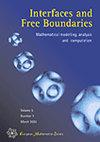多孔介质方程两相扩展的大时间行为
IF 1
4区 数学
Q1 MATHEMATICS
引用次数: 7
摘要
我们研究了模拟海水入侵问题的多孔介质方程的两相扩展解的大时间行为。目标是识别与问题的缩放版本的稳定状态相对应的自相似解决方案。我们完全描述了唯一的稳定状态,被确定为一个凸能量的最小值,并显示为径向对称。此外,我们还证明了当时间趋于无穷时,时间依赖模型解向唯一定态的收敛性。我们最后提供了稳态的数值说明,并展示了数值收敛速率。本文章由计算机程序翻译,如有差异,请以英文原文为准。
Large time behavior of a two phase extension of the porous medium equation
We study the large time behavior of the solutions to a two phase extension of the porous medium equation, which models the so-called seawater intrusion problem. The goal is to identify the self-similar solutions that correspond to steady states of a rescaled version of the problem. We fully characterize the unique steady states that are identified as minimizers of a convex energy and shown to be radially symmetric. Moreover, we prove the convergence of the solution to the time-dependent model towards the unique stationary state as time goes to infinity. We finally provide numerical illustrations of the stationary states and we exhibit numerical convergence rates.
求助全文
通过发布文献求助,成功后即可免费获取论文全文。
去求助
来源期刊
CiteScore
1.70
自引率
0.00%
发文量
17
审稿时长
>12 weeks
期刊介绍:
Interfaces and Free Boundaries is dedicated to the mathematical modelling, analysis and computation of interfaces and free boundary problems in all areas where such phenomena are pertinent. The journal aims to be a forum where mathematical analysis, partial differential equations, modelling, scientific computing and the various applications which involve mathematical modelling meet. Submissions should, ideally, emphasize the combination of theory and application.

 求助内容:
求助内容: 应助结果提醒方式:
应助结果提醒方式:


